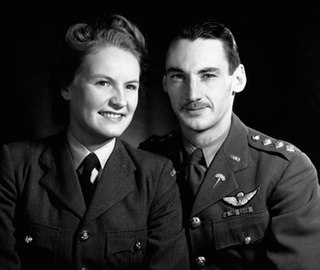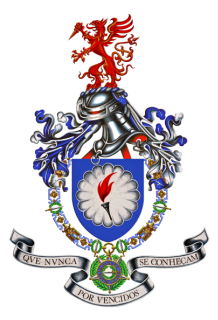Role
As opposed to a purely military function, the Canadian SAS was originally given functions of airborne firefighting, search and rescue and aid to the civil powers. [2] However, once officially sanctioned, the SAS was assigned the functions of being initially a parachute company but able to be the cadre of up to three parachute battalions, provide demonstrations of their capabilities throughout the nation, and "preserve and advance the techniques of SAS (Commando) operations developed during World War II". [2]
The Canadian SAS Company performed an arctic rescue mission in 1947 and provided flood relief efforts in the Fraser Valley in 1948. [1]

A paratrooper is a military parachutist—someone trained to parachute into an operation, and usually functioning as part of an airborne force. Military parachutists (troops) and parachutes were first used on a large scale during World War II for troop distribution and transportation. Paratroopers are often used in surprise attacks, to seize strategic objectives such as airfields or bridges.

A commando is a combatant, or operative of an elite light infantry or special operations force using dedicated operation techniques.

A long-range reconnaissance patrol, or LRRP, is a small, well-armed reconnaissance team that patrols deep in enemy-held territory.

In military organizations, a pathfinder is a specialized soldier inserted or dropped into place in order to set up and operate drop zones, pickup zones, and helicopter landing sites for airborne operations, air resupply operations, or other air operations in support of the ground unit commander. Pathfinders first appeared in World War II, where they served with distinction, and continue to serve an important role in today's modern armed forces, providing commanders with the option of flexibly employing air assets.

The Canadian Airborne Regiment was a Canadian Forces formation created on April 8, 1968. It was not an administrative regiment in the commonly accepted British Commonwealth sense, but rather a tactical formation manned from other regiments and branches. It was disbanded in 1995 after the Somalia affair.

The Special Forces Support Group (SFSG) is a unit of the British Armed Forces. The SFSG is the newest addition to the United Kingdom Special Forces. It was formed officially on 3 April 2006 to provide specialist infantry and other support to the Special Air Service, the Special Reconnaissance Regiment and the Special Boat Service on operations. A tri-service unit, the major element of the SFSG is 1st Battalion, The Parachute Regiment, reinforced with a company strength group of the Royal Marines. Specialists from the RAF Regiment also form part of the SFSG's strength. The SFSG may provide extra firepower from land or air to fulfil their mission.

Major Lionel Guy d'Artois was a Canadian Army officer and SOE agent.

The maroon beret in a military configuration has been an international symbol of airborne forces since the Second World War. It was first officially introduced by the British Army in 1942, at the direction of Major-General Frederick "Boy" Browning, commander of the British 1st Airborne Division. It was first worn by the Parachute Regiment in action in North Africa during November 1942.

The Regimento de Paraquedistas, based in Tancos, Portugal, is a unit of the Portuguese Army and serves as the instruction center for recruitment and training of the Portuguese paratroopers. This unit includes an entire battalion, acting as support and reserve for airborne units which contains for example, military war dogs and airborne pathfinders and an instruction battalion responsible for the forming of new paratroopers.

The 1st Canadian Parachute Battalion was an airborne infantry battalion of the Canadian Army formed in July 1942 during the Second World War; it served in North West Europe, Landing in Normandy during Operation Tonga, in conjunction with the D-Day landings of 6 June 1944 and in the airborne assault crossing of the River Rhine, Operation Varsity, in March 1945. After the end of hostilities in Europe, the battalion was returned to Canada where it was disbanded on 30 September 1945.

Special forces and special operations forces (SOF) are military units trained to conduct special operations. NATO has defined special operations as "military activities conducted by specially designated, organized, trained, and equipped forces, manned with selected personnel, using unconventional tactics, techniques, and modes of employment".

The 5th Special Air Service was an elite airborne unit during World War II. It consisted entirely of Belgian volunteers. It saw action as part of the SAS Brigade in Normandy, Northern France, Belgium, the Netherlands and (Germany). Initially trained in sabotage and intelligence gathering, they converted to motorized reconnaissance on armored jeeps. They were the first Allied unit to set foot onto Belgian soil and the first to cross the Siegfried line, albeit accidentally.

The 8th (Midlands) Parachute Battalion was an airborne infantry battalion of the Parachute Regiment, raised by the British Army during the Second World War. The battalion was created in late 1942 by the conversion of the 13th Battalion, Royal Warwickshire Regiment to parachute duties. The battalion was assigned to the 3rd Parachute Brigade, serving alongside the 7th and 9th Parachute battalions, in the 1st Airborne Division before being reassigned to help form the 6th Airborne Division in May 1943.

The 5th (Scottish) Parachute Battalion was an airborne infantry battalion of the Parachute Regiment, raised by the British Army during the Second World War.

The 6th Parachute Battalion was an airborne infantry battalion of the Parachute Regiment raised by the British Army during the Second World War.

Airborne forces raised by Australia have included a number of conventional and special forces units. During the Second World War the Australian Army formed the 1st Parachute Battalion; however, it did not see action. In the post-war period Australia's parachute capability was primarily maintained by special forces units. In the early 1980s a parachute infantry capability was revived which led to the Parachute Battalion Group forming in 1983 based on the 3rd Battalion, Royal Australian Regiment. In 1997, a full time commando regiment was raised that was able to conduct large-scale operations which matured during the 2000s. In 2011, 3 RAR relinquished the parachute role with the Army deciding to opt out of a conventional parachute capability in preference to a special forces large-scale parachute capability.













